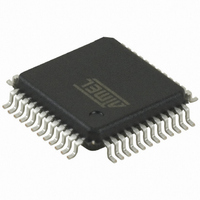AT32UC3B1256-AUR Atmel, AT32UC3B1256-AUR Datasheet - Page 376

AT32UC3B1256-AUR
Manufacturer Part Number
AT32UC3B1256-AUR
Description
MCU AVR32 256K FLASH 48-TQFP
Manufacturer
Atmel
Series
AVR®32 UC3r
Datasheet
1.AT32UC3B164-AUR.pdf
(680 pages)
Specifications of AT32UC3B1256-AUR
Package / Case
48-TQFP, 48-VQFP
Voltage - Supply (vcc/vdd)
1.65 V ~ 1.95 V
Operating Temperature
-40°C ~ 85°C
Speed
60MHz
Number Of I /o
28
Core Processor
AVR
Program Memory Type
FLASH
Ram Size
32K x 8
Program Memory Size
256KB (256K x 8)
Data Converters
A/D 6x10b
Oscillator Type
Internal
Peripherals
Brown-out Detect/Reset, DMA, POR, PWM, WDT
Connectivity
I²C, IrDA, SPI, SSC, UART/USART, USB
Core Size
32-Bit
Lead Free Status / RoHS Status
Lead free / RoHS Compliant
Eeprom Size
-
Available stocks
Company
Part Number
Manufacturer
Quantity
Price
Company:
Part Number:
AT32UC3B1256-AUR
Manufacturer:
OMRON
Quantity:
12 000
- Current page: 376 of 680
- Download datasheet (10Mb)
22.7.1.5
22.7.1.6
32059J–12/2010
Speed control
DPRAM management
•USB Suspend mode
•Device mode
•Host mode
• The Host Wake-up Interrupt (HWUPI)
In peripheral mode, the Suspend Interrupt bit in the Device Global Interrupt register
(UDINT.SUSP)indicates that the USB line is in the suspend mode. In this case, the USB Data
UTMI transceiver is automatically set in suspend mode to reduce the consumption.
When the USBB interface is in device mode, the speed selection (full-/low-speed) depends on
which of D+ and D- is pulled up. The LS bit allows to connect an internal pull-up resistor either
on D+ (full-speed mode) or on D- (low-speed mode). The LS bit shall be written before attaching
the device, what can be done by clearing the DETACH bit in UDCON.
Figure 22-7. Speed Selection in Device Mode
When the USB interface is in host mode, internal pull-down resistors are connected on both D+
and D- and the interface detects the speed of the connected device, which is reflected by the
Speed Status (SPEED) field in USBSTA.
Pipes and endpoints can only be allocated in ascending order (from the pipe/endpoint 0 to the
last pipe/endpoint to be allocated). The user shall therefore configure them in the same order.
The allocation of a pipe/endpoint n starts when the Endpoint Memory Allocate bit in the Endpoint
n Configuration register (UECFGn.ALLOC) is written to one. Then, the hardware allocates a
memory area in the DPRAM and inserts it between the n-1 and n+1 pipes/endpoints. The n+1
pipe/endpoint memory window slides up and its data is lost. Note that the following pipe/end-
point memory windows (from n+2) do not slide.
Disabling a pipe, by writing a zero to the Pipe n Enable bit in the Pipe Enable/Reset register
(UPRST.PENn), or disabling an endpoint, by writing a zero to the Endpoint n Enable bit in the
Endpoint Enable/Reset register (UERST.EPENn), resets neither the UECFGn.ALLOC bit nor its
VBUS
D+
D-
UDCON.DETACH
UDCON.LS
AT32UC3B
376
Related parts for AT32UC3B1256-AUR
Image
Part Number
Description
Manufacturer
Datasheet
Request
R

Part Number:
Description:
DEV KIT FOR AVR/AVR32
Manufacturer:
Atmel
Datasheet:

Part Number:
Description:
INTERVAL AND WIPE/WASH WIPER CONTROL IC WITH DELAY
Manufacturer:
ATMEL Corporation
Datasheet:

Part Number:
Description:
Low-Voltage Voice-Switched IC for Hands-Free Operation
Manufacturer:
ATMEL Corporation
Datasheet:

Part Number:
Description:
MONOLITHIC INTEGRATED FEATUREPHONE CIRCUIT
Manufacturer:
ATMEL Corporation
Datasheet:

Part Number:
Description:
AM-FM Receiver IC U4255BM-M
Manufacturer:
ATMEL Corporation
Datasheet:

Part Number:
Description:
Monolithic Integrated Feature Phone Circuit
Manufacturer:
ATMEL Corporation
Datasheet:

Part Number:
Description:
Multistandard Video-IF and Quasi Parallel Sound Processing
Manufacturer:
ATMEL Corporation
Datasheet:

Part Number:
Description:
High-performance EE PLD
Manufacturer:
ATMEL Corporation
Datasheet:

Part Number:
Description:
8-bit Flash Microcontroller
Manufacturer:
ATMEL Corporation
Datasheet:

Part Number:
Description:
2-Wire Serial EEPROM
Manufacturer:
ATMEL Corporation
Datasheet:











